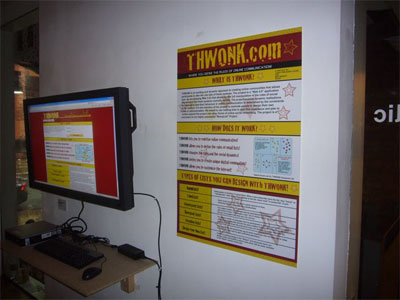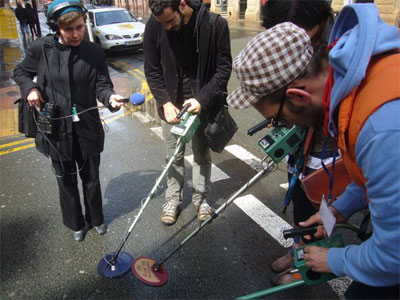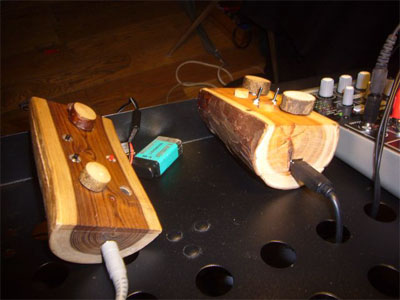
Focusing on a wide array of themes such as the context of a rapidly changing planet, our evolving human / natural ecosystem, the growing global strain on natural resources, and the advancement of artistic methods on potential of technological infrastructures, the 10th edition of the FutureSonic festival spanning 14 years integrated a wide and impressive array of international speakers, workshops, exhibitions, and performances. Scattered around the bustling city of Manchester in the United Kingdom, the festival took into account both its local strengths and its global outreach to encourage debate and showcase a wide arrange of artistic projects that examined just how far we have come in these debates and how far we have to go to make sense of the evolving technological apparatus that surrounds us.
The Contact theater on the campus of the University of Manchester served as the main venue for the symposium talks and workshops. Opening the debate, keynote speaker Jamais Casio, an affiliate of the Institute for the Future, spoke about the ecological and economic tensions that global climate change, population density, and bio engineering have created on our fragile planet. Cascio sees a future where "nature is no longer natural" and our planet can be easily "hacked" through methods of pervasive "geo-engineering". Although an outspoken heckler in the audience seemed to disagree with his points, the debate was an interesting introduction to how FutureSonic is positioning itself into a festival focused on presenting a wider array of viewpoints and multidisciplinary perspectives in its transition next year to the new name, "Future Everything".
Speaking specifically about the pervasive use of networks, innovative thinker and author Stowe Boyd began a discussion on what he coined as "social tools" of technology and how they are shaping our world views and the future of culture. Beginning by referencing Marshall McLuhan's thoughts on "Global Computer Automization" or a prediction the theorist had for a pre-Internet, "global network that would change everything", Boyd explained that social tools must have mass participation in order for them to bring about significant impact and that “social” has begun to mean "me first" where the individual is the replacement for the old "group". He cited the shift from the use of email to microblogging sites like Twitter as an inevitable trend towards more transparent system structures. The last speaker of the day was James Marriott of "PLATFORM", a group of artists and curators that integrate methods of activism and ecological justice to campaign for social change. Reinforcing Boyd's stance on the increasing power of networked social tools, Marriott explained that by leveraging the power of these forms of communication, transparency increases while risks also emerge.
The next day started with the Environment 2.0 panel that focused on both the visualization of global environmental concerns as well as an engagement with the public about their use of technology and natural resources. London-based artist, Usman Haque began the session by outlining his Pachube project, a networked system of environmental sensors that features an open API for hardware sensing that allows for distributed environmental monitoring and data acquisition. Haque's Natural Fuse project, on display in the Cube gallery, further extrapolated on this year's environmental theme and consisted of a purchase-able electrical socket equipped with a plant that created a "carbon sink" for the energy being consumed. Tapio Makela also spoke about his M.A.R.I.N. (Media Art Research Interdisciplinary Network) that focuses on what he calls "Ecolocation" or the connections between locative media, ecology, and environmental information design. Next, artist Aaron Koblin of Google's Creative Lab showcased several of his data visualization projects that featured graphical interpretations of communication patterns of both SMS and telephone calls between major metropolitan cities such as New York and Amsterdam as well as a project that sonified these broadcasts from major networks such as CNBC and the Oxygen Channel.
The Friday talks began with Nokia user experience designer and author Adam Greenfield who spoke about the advent of ubiquitous computing and its effect on the population at large. In his presentation, based on the forthcoming book The City is Here for You to Use, Greenfield discussed a diagnosis and manifesto for what he called "networked urbanism" where networked sensors will eventually account for 20% of non-video based Internet traffic. He claimed that one must understand networked devices, vehicles, institutions and their integration into the architecture of cities in order to understand them. He proclaimed that the fact that, for the first time in history, a map can now show you where you are on it changes its function from a mere passive document to an active instrument. Following this discussion, Stefan Agamanolis, Chief Executive of Distance Lab, a research lab in northern Scotland, spoke about the potentials of technology to aid in trying to solve the disadvantages of distance. His talk, titled "The Communications Burger" used the example of fast food as an efficient yet impersonal method of communication and attempted to show how, by provoking new methods of communication through expressive methodologies, it was possible to relieve the strain of distance between people. To illustrate this, he explained his lab's "Boxing over a Distance" project which allowed two participants the ability to "punch each other" over a networked surface that would actuate to cause physical feedback to the users.
Overall, this panel was meant to address how our dependence on mobile technology is both opening up new possibilities for engagement with urban spaces as well as provoking new methods for experiencing and visualizing our rapidly changing and connected environment. In the other panels and discussions, I presented an overview of my PhD work into "Deconstructing Networks", focusing on an array of projects I have completed that attempt to critically engage and deconstruct methods and metaphors of connectivity, pervasive technological infrastructures, and mass communication. I also launched a new project at the festival with Mike Bennett called THWONK, which is a new form of social networking platform that allows the public to write the social rules of online communication, beginning with email lists and branching out into other forms of systems. This form of participatory platform was a focal point for the festival that is aiming for further inclusion into cross-disciplinary pollination into multiple media forms and directions. Although I was unable to attend every panel in this year's festival, the overall theme centered on our ongoing connection to and integration with place, technology, information, environment, and networks.

One of the key new elements to this year's festival included an "OpenLab" which consisted of a workshop where practitioners and artists could openly discuss issues of global climate change and how they could be addressed through locative media projects that focused on political, environmental, and social aspects surrounding this debate. "For me it's a really significant step because it's like putting the "ethics" into locative media," explained Drew Hemment, the founder and festival director. The Open Lab featured talks by Christian Nold on his Bio-Tagging project which features "EVE”, a trolly with CCTV cameras and heat monitoring sensors with the ability to track local wildlife and other natural forms in order to situate and make sense of the natural habitats of local areas. The project also contributes to citizen science projects with the intent to collect data and enable mass participation of environmental reports and studies. Another project in this vein was Climate Bubbles done in collaboration with the Manchester Met office (an office that focuses on environmental concerns) where "bubble kits" were distributed to the local population and made into a downloadable Instructable. Participants were then asked to blow thousands of bubbles into the air, which was then used in a form of crowd-sourced air flow measurement system that tracked and mapped bubbles in order to discover the emergence of local micro-climates in the city.
The exhibition in the Cube gallery, located in the heart of the city, featured a wide array of projects that examined the theme of "Environment 2.0". Projects in this venue included a festival commission by San Francisco-based artist Amy Balkin called Reading the PCC Fourth Assessment Report where the artist recited the rarely heard report by the Intergovernmental Panel on Climate Change to the public over the course of the exhibition. Another commission was by a New York City-based artist John Cohrs, titled Urban Prospecting which commented on society’s relentless addiction to oil. For this project, Cohrs led groups of people around Manchester carrying custom designed hardware devices fashioned from old metal detectors with embedded hydrocarbon sensors to "search for "oil" in the city centre. Instructions for building the devices are also available on Instructables.com. One of the most startling pieces in the exhibition was Los Angeles-based artist Kim Abeles' Presidential Commemorative Smog Plates which consisted of several portraits of US presidents made from applying transparent adhesive material onto dinner plates and leaving them outside in Los Angeles to collect debris and pollution from the city’s thick smog in order to create the images. The resulting portraits were covered in blackened and sooty smog debris, and did not make you want to visit Los Angeles.

Downstairs in the Cube was a showcase of work built in collaboration between Yamaha Japan and the Royal College of Art's Design Products program where the task was to create a new form of musical instrument. This exhibition focused on the theme of "Making Fun Serious" where projects emphasized the playful nature of devices and objects in both domestic and public spaces. One interesting piece in the show was Furniture for the Musical Human by Vahakn Matossian-Gehlaar, which consisted of a performance space built into the shape of a chair. When the person in the chair speaks into an integrated microphone, their voice is digitally processed and amplified while a joystick allows them to send their sound to distributed speakers embedded in the chair's body. Also working within the sonic landscape, Azusa Murakami's Knittophone creates music by pushing a custom built reader over the dark and light threads sewn into a series of knit scarves. This simple interaction attempted to create a hybrid connection between clothing and the phenomenon of QR and UPC code scanning that we use daily. Other highlights from the exhibition included a performance by Manchester's Owl Project who integrates electronics and digital devices into wooden objects and enclosures such as their iPod variant, the "iLog" which trades the iPod's capacitive sensing for wooden knobs that might lead to splinters after increased usage.


As the festival wound down, there was a sense that FutureSonic is situated on the precipice of significant change and fluent promise. Projects, artists, commissions, and invited speakers combined to make it a worthwhile event and its dedication to finding a space for novel forms of cross-disciplinary interaction make it a unique venue for both encouraging collaboration and strengthening relationships between diverse communities involved in fields ranging from scientific exploration, media art interventions, and musical ingenuity. With next year's reemergence as "FutureEverything", Hemment hopes that the festival will attract even more practitioners in multiple fields. Despite the festival's rich history, Hemment saw its name as a crutch in attracting a wider range of audiences and artist networks to get involved. Hopefully with its new birth next year, 2010 will be a banner year in building it into even more of a major destination for creative innovators across the globe.
Jonah Brucker-Cohen is a researcher, artist, and Ph.D. candidate as an HEA MMRP (Multimedia Research Programme) fellow in the Disruptive Design Team of the Networking and Telecommunications Research Group (NTRG), Trinity College Dublin. He is an adjunct assistant professor of communications at NYU's Interactive Telecommunications Program (ITP). He is co-founder of the Dublin Art and Technology Association (DATA Group) and a recipient of the ARANEUM Prize sponsored by the Spanish Ministry of Art, Science and Technology and Fundacion ARCO. His writing has appeared in numerous international publications including WIRED Magazine, Make Magazine, Rhizome.org, and Gizmodo, and his work has been shown at events such as DEAF (03,04), Art Futura (04), SIGGRAPH (00,05), UBICOMP (02,03,04), CHI (04,06) Transmediale (02,04,08), NIME (07), ISEA (02,04,06), Institute of Contemporary Art in London (04), Whitney Museum of American Art's ArtPort (03), Ars Electronica (02,04,08), Chelsea Art Museum, ZKM Museum of Contemporary Art (04-5),Museum of Modern Art (MOMA - NYC)(2008), and the San Francisco Museum of Modern Art (SFMOMA) (2008). He blogs at coin-operated.


Indeed, with the likes of products being produced by Sonny; the world will have no option than to be what we all have always wanted it to be in terms of entertainment, arts and so on.
Who is Sonny?
sonny is dead.
Sonny is my best friend.. he's dead!?? shit.